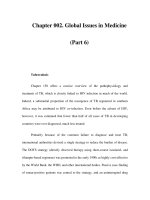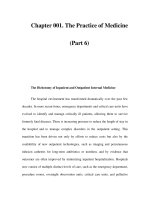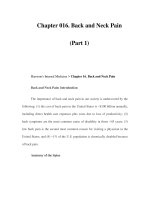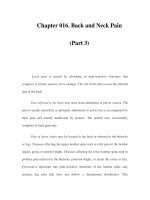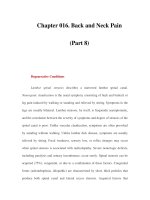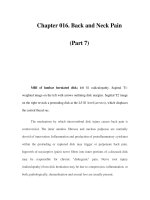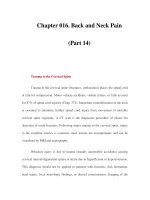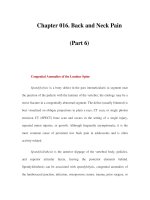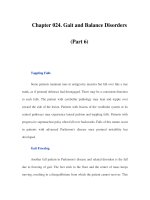Chapter 073. Enteral and Parenteral Nutrition (Part 6) ppsx
Bạn đang xem bản rút gọn của tài liệu. Xem và tải ngay bản đầy đủ của tài liệu tại đây (12.1 KB, 5 trang )
Chapter 073. Enteral and
Parenteral Nutrition
(Part 6)
Energy Requirements
Total energy expenditure comprises resting energy expenditure (two-thirds)
plus activity energy expenditure (one-third) (Chap. 72). Resting energy
expenditure includes the calories necessary for basal metabolism at bed rest.
Activity energy expenditure represents one-fourth to one-third of the total, and the
thermal effect of feeding is about 10% of the total energy expenditure. For
normally nourished healthy individuals, the total energy expenditure is about 30–
35 kcal/kg. Although critical illness increases resting energy expenditure, only in
initially well-nourished individuals with the highest systemic inflammatory
response, such as that from severe multiple trauma, burns, closed head injury, or
sepsis, do total energy expenditures reach 40–45 kcal/kg. The chronically ill
patient with lean tissue loss has reduced basal energy expenditure, and inactivity
which results in a total energy expenditure of about 20–25 kcal/kg. About 95% of
such patients need <30 kcal/kg to achieve energy balance. Because providing
about 50% of measured energy expenditure as SNS is at least equally efficacious
for the first 10 days of critical illness, actual measurement of energy expenditure is
not generally necessary in the early period of SNS. However, in patients who
remain critically ill beyond several weeks, in the severely malnourished for whom
estimates of energy expenditure are unreliable, or in those who are difficult to
wean from ventilators, it is reasonable to actually measure energy expenditure and
to aim for energy balance with SNS.
Insulin resistance is associated with increased gluconeogenesis and reduced
glucose utilization, predisposing a patient to hyperglycemia. This is aggravated in
patients receiving exogenous carbohydrate from SNS. Normalization of blood
glucose levels by insulin infusion in critically ill patients receiving SNS reduces
morbidity and mortality. In mild or moderately malnourished patients, a
reasonable goal is to provide metabolic support to improve protein synthesis and
maintain metabolic homeostasis. Hypocaloric nutrition providing only about 1000
kcal/d and 70 g protein for up to 10 days requires less fluid and reduces the
likelihood of poor glycemic control. Energy content can be advanced to 20–25
kcal/kg with 1.5 g protein/kg as conditions permit and definitely during the second
week of SNS. Patients with multiple trauma, closed head injury, and severe burns
often have much higher energy expenditures, but there is little evidence that
providing more than 30 kcal/kg has additional benefit, and it risks hyperglycemia.
Generally, because glucose is an essential tissue fuel, glucose and amino
acids are provided parenterally until the level of resting energy expenditure is
reached. At this point, adding fat becomes beneficial, since more parenteral
glucose stimulates de novo lipogenesis by the liver—an energy-inefficient process.
Polyunsaturated long-chain triglycerides are the chief ingredient in most
parenteral fat emulsions and the majority of the fat in enteral feeding formulas.
These vegetable oil–based emulsions provide essential fatty acids. Enteral feeding
formulas have fat content that ranges from 3% of calories up to as much as 50% of
calories, while parenteral fat comes in separate containers as 10, 20, and 30%
emulsions that can be infused separately or mixed by the pharmacy under
controlled conditions as all-in-one or total nutrient admixture with glucose, amino
acids, lipid, electrolytes, vitamins, and minerals.
Although parenteral fat is required at only about 3% of energy requirements
to meet essential fatty acid requirements, when provided as an all-in-one mixture
of carbohydrate, fat, and protein, 2–3% fat in the TPN mixtures, representing
about 20–30% of calories as fat, is provided to ensure emulsion stability. If given
separately, parenteral fat should not be provided at rates exceeding 0.11 g/kg body
weight per h or about 100 g over 12 h—equivalent to 1 L of 10% parenteral fat
and 500 mL of 20% parenteral fat.
Medium-chain triglycerides, which contain saturated fatty acids with chain
lengths of 6, 8, 10, or 12 carbons, are provided in a number of enteral feeding
formulas because they are absorbed preferentially.
Fish oil contains polyunsaturated fatty acids of the omega 3 family, which
have been shown to improve immune function and reduce the inflammatory
response. Parenteral emulsions containing medium-chain triglycerides, olive oil,
and fish oil are available in Europe and Japan but not yet in the United States.
Carbohydrates are provided as hydrous glucose providing 3.4 kcal/g in PN
formulas. In enteral formulas, glucose is the carbohydrate source in so-called
monomeric diets. These diets provide protein as amino acids and fat in minimal
amounts (3%) to meet essential fatty acid requirements.
Monomeric formulas are designed to optimize absorption in the seriously
compromised gut. These formulas, like the immune-enhancing diets, are quite
expensive. In polymeric diets, the carbohydrate source is usually an osmotically
less active polysaccharide, protein is usually soy or casein protein, and fat is
present in amounts from 25 to 50%. Such formulas are usually well tolerated by
patients with normal intestinal length, and some are acceptable for oral
consumption.
